Zealous car hunters and restorers have long ago discovered the chassis numbers, whereabouts, and current fate of the Maseratis, Ferraris and HWM that were the stars of the legendary 1954 classic movie “The Racers”.
But there was one car that had a small role in the movie and was perhaps as beautiful as the female lead in the movie, Bella Darvi. And now, that too, has been discovered.
Or so we think. Find out next week and perhaps our readers can help us determine if it’s the real thing. In the meantime, with image artist, writer and photographer Peter Darnall’s help we offer up this story about the book and the movie to provide some background to the recent find.
Although Hollywood had dabbled in racing movies before 1955, none had ever used the European racing scene as a backdrop; no Hollywood director had carried the cameras to the Nurburgring or to Spa or the Mille Miglia until 20th Century Fox decided to film a movie based on a novel, “The Racer,” by writer/racedriver Hans Ruesch, which had appeared as a hardback and -paperback in 1953. Alfa Romeo-owning Ruesch himself was a true character, and Peter Darnall will tell us more about him in a future article. Here, Darnall recalls when he first got his hands a copy of Ruesch’s “The Racer” only to have it rudely taken away:
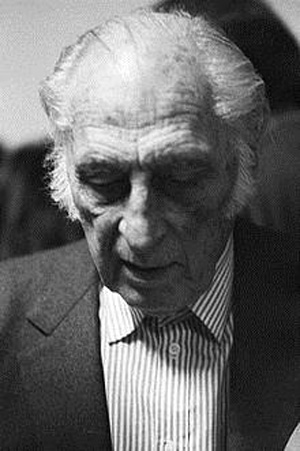
Hans Ruesch in 1993. Wiki photo.
There are a few books that are just special. My copy of “The Racer” falls into this category and it sits in a place of honor. The book is quite worn now. The scotch tape holding the torn jacket together is brittle and has turned yellow with age. The “Ex Libris” stamp with my name on it is still there proudly displayed on the inside of the front cover. Good thing—I probably wouldn’t have the book today if that stamp hadn’t been there. Let’s start in the beginning.
It seems like only yesterday, but it was 62 years ago. The spring of 1954, to be exact, and I was fifteen years old at the time. I can still remember the bookstore owner’s disapproving frown as he followed me to the magazine rack and watched me take down the latest issue of “Photography” magazine. Out of the corner of my eye, however, I caught a glimpse of something interesting. I put the unopened magazine back on the shelf and walked over to the new book display. It was the book’s cover that had drawn me like a magnet—an artist’s rendition of race cars against a background of a winding road racing circuit. What a find! My whole world revolved around sports cars and road racing at that time. I paid the $1.50 hardcover price and walked out with my new purchase. Take my word for it, you can judge a book by its cover.
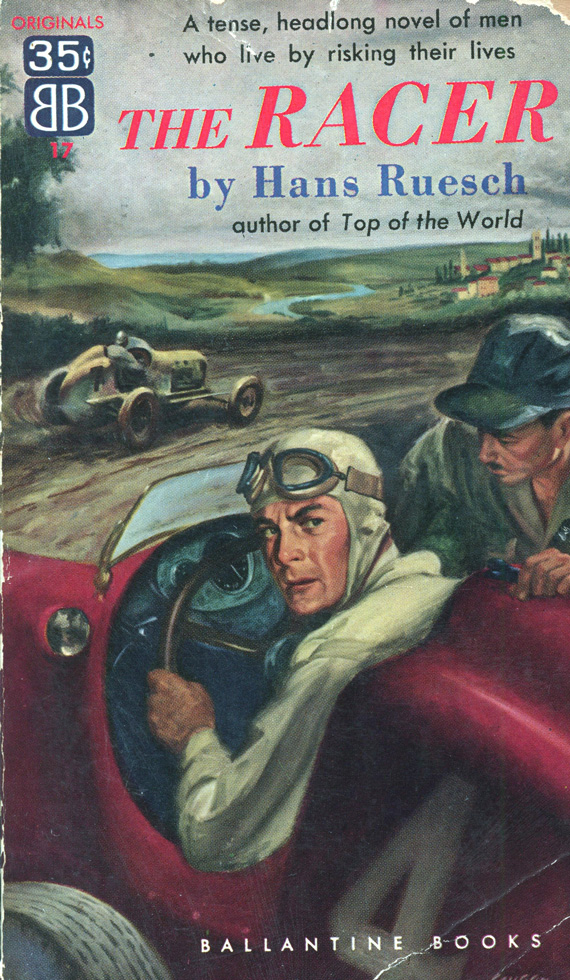
The 1953 Ballantine paperback edition of Ruesch’s book had a sprint car on dirt in the background, no doubt to catch the attention of Americans who knew only oval car racing.
You can stay son but the book’s gotta go…
The book’s main character is Erich Lester. His ruthless driving style had earned him a position on the dominant German team. His ambition to be the best costs him dearly and he is badly injured in a crash. I’ve read the book from cover to cover several times over the years. Thumbing through the pages now brings back the exact feelings I felt when I read the book for the first time.
That’s when the trouble began. . .
I was well into the story. Erich Lester was on the pole position and was starting his first race for the German team. The text on page 61 reads: “… at five seconds the starter began counting on his outspread fingers, closing one after the other, and Lester released his handbrake. The car began nosing forward…”
I remember a smell of stale cigarette smoke and garlic filling the classroom. An arm suddenly appeared from above and grabbed my book. An angry voice rasped, “I’ll take that book, young man.”
My world of motor racing was suddenly shattered. I hadn’t noticed that my physics teacher, “Wild Bill” Emery, had walked up behind me. Wild Bill now had my book in his right hand and was holding it up like a trophy.
The whole class was laughing—not a good moment. I was sent to the principal’s office and was not see my book again for a long time.
It took a written note signed by my parents and a lot of talking on my part to get my book returned. It had been in exile for about six months. Wild Bill’s drawer was crammed full of reading material and other paraphernalia which he had taken from students over the years.
Fortunately my “Ex Libris” label on the inside cover had my name on it providing positive identification. My book was grudgingly handed back but it had suffered considerable damage during its captivity. Today the torn cover appears to me like a mark of honor, akin to the dueling scars sported years ago by young Austrian university students.
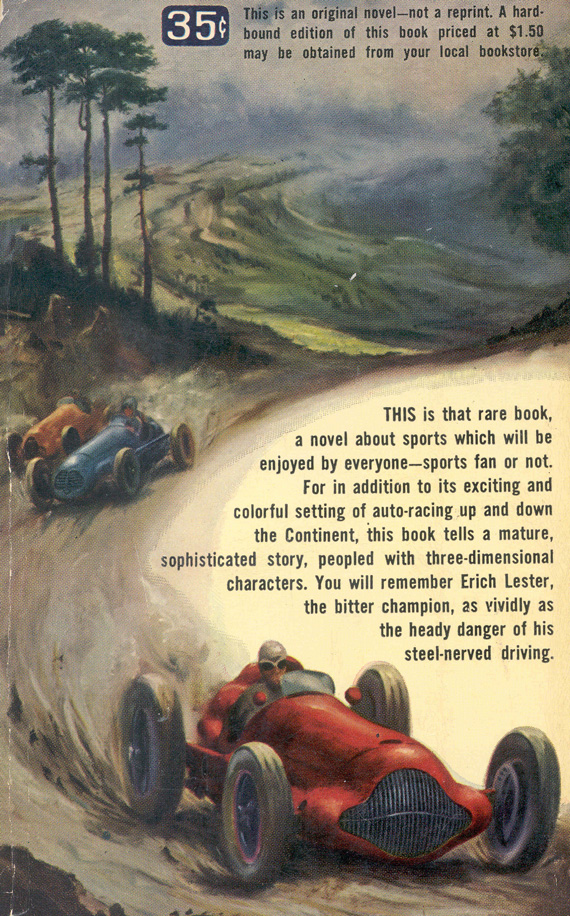
Back cover of the Ruesch paperback was a little better. A red W154 Mercedes in the foreground, a Maserati and Alfa 158 in the background.
When “The Racers” came to Berkeley
What Darnall didn’t know at the time was that his coveted book was about to become a major motion picture featuring an all-star cast. Director Henry Hathaway (1898-1985) called his movie “The Racers” (plural) and suddenly brought an unknown world of exotic cars, places, and names to the silver screen and to a largely ignorant mainstream America
Apart from the cosmopolitan areas of New York, Chicago and Los Angeles, sports cars, racing, and European Grand Prix events were either unheard of or ignored. Even foreign passenger cars were rare. In 1954, a year when Detroit produced 5.5 million cars, the total number of imports was 25,786, with Volkswagen at 6,344 units leading the tiny pack. There were nine new Ferraris registered. The only magazine to cover any European racing was Road & Track, still in its infancy. The press, when is was paying attention, was openly hostile to racing. The only event that rated any coverage at all was Indianapolis, which was broadcast live on radio. Barring accidents, auto racing simply didn’t ring bells in the U.S.
Imagine, then, the pleasure with which foreign car enthusiasts received the movie “The Racers”, which hit the nation’s theaters in the summer of 1955. Suddenly, the sepia toned postage stamp photos of the major Grand Prixs and the Mille Miglia seen only in Road & Track came to life in full Hollywood CinemaScope. For the first time, one could see and hear Ascari, Villoresi, Fangio, and the cars they drove.
The plot was as bad as any Hollywood could muster and the dialogue was cornier than Kansas in August. None of the cast filmed in Europe, but stayed on Hollywood sets that duplicated those filmed in Europe. But all that didn’t matter. The scenes filmed in Europe during the 1954 season were, and still are outstanding and achieved with state-of-the-art filming equipment
It wasn’t long after retrieving his copy of “The Racer” that the movie came to Berkeley, California where Peter Darnall was living and he still remembers the day he first saw the film:
Berkeley was something of a focal point in the sports car renaissance which began in the early 1950s. Road racing events at nearby venues, such as Golden Gate Park and Pebble Beach, had introduced European-style road racing. The cars which competed in these events were unlike anything I had ever seen before. Imagine a comparison between the ’51 Mercury, which my family owned, and a Jaguar XK-120.
Jaguars and MGs, although not common, were seen on the streets of Berkeley in those days. My subscription to Road & Track magazine brought monthly issues with tantalizing glimpses of European-style racing and exotic cars. My well-worn edition of “The Kings of the Road” introduced me to Ken Purdy’s marvelous prose; his description of the brutal acceleration of the Mercedes Benz W125 grand prix car set my standard for excellence in automotive journalism.
As a high school student, I participated in creative writing classes and wrote endlessly about the Bugattis, Alfa Romeos, and Mercedes Benz cars which raced on the great circuits of Europe in the 1930s. Although I had never seen these machines, I created mental images of the action for my essays which were based on written accounts gleaned from books and magazines.
Then “The Racers”, a major Hollywood CinemaScope production, came to Berkeley. I remember going to the Fox Theater to see The Racers. Judging from the number of sports cars parked nearby, the local enthusiasts shared my interest. When the curtains rolled back to reveal the wide screen for the CinemaScope production and the film credit documenting Phil Hill’s technical assistance appeared, a loud cheer from the audience broke out. The cheering slowly faded into a respectful silence as the opening scenes turned to racing on the streets of Monte Carlo.
Although the plot was forgettable, the photography was spectacular. This was racing as I had imagined it. When the film ended, spontaneous clapping and respectful cheering broke out.
These characters also passed onto the silver screen, personalities intact. Erich Lester, a German citizen in Ruesch’s book, is transplanted to Italy for the movie version, renamed Gino Borgesa, (played by Kirk Douglas) and the racing takes place in 1952-1954 timeframe. Bella Darvi portrays a professional ballerina who falls for Borgesa, a major change from Ruesch’s plot.
So what happened to the beautiful Darvi?
Now 99, Kirk Douglas who portrayed a particularly bitter Borgesa,is a Hollywood legend. Fellow drivers Cesar Romero and Gilbert Roland, enjoyed long careers in the movies and both died in 1994. Lee J. Cobb, who was so obviously Alfred Neubauer, left the stage forever in 1976. The fate of the beautiful Bella Darvi, a Pole whose real name was Bayla Wegier, was not so happy. A survivor of the Nazi concentration camps, she later lived in Paris and was discovered gambling at a casino by Fox Studio head Darryl B. Zanuck, who thought she had potential. He and his wife befriended her, and took her to Hollywood to live in their home. In true Hollywood style, Zanuck and Bela were caught red handed by Zanuck’s wife. Bela was thrown out, went to Europe to gamble and found work in B rated movies. She committed suicide in September 1971, still in debt over gambling. Ironically, her big scene at the Monte Carlo Casino, where she gambles to win the money for Borgesa’s new race car, was the only scene in which she didn’t really have to act.
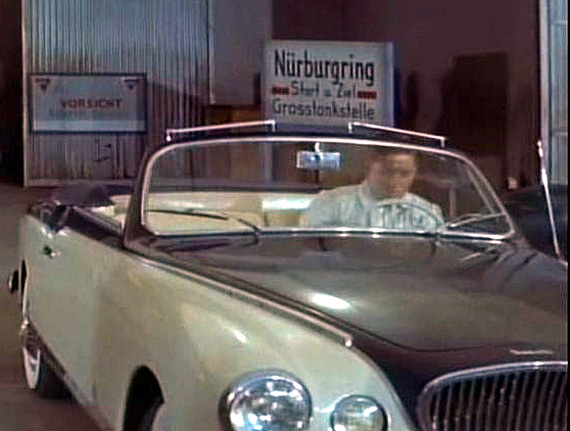
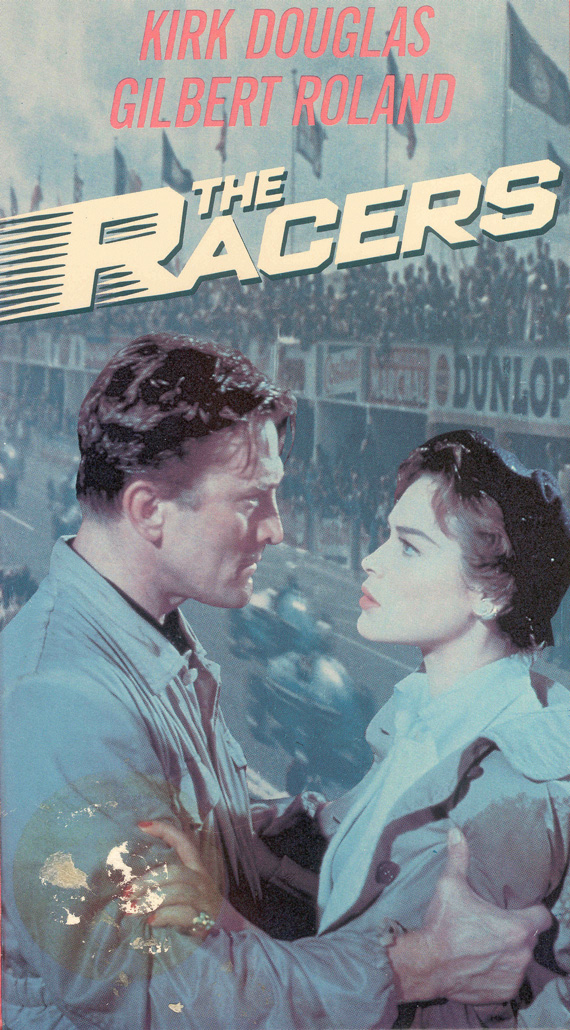

What wonderful and fascinating historical background to the favorite story of so many automotive enthusiasts. Many of us had similar personal experiences to those related in this story, making it all so very realistic!
i saw it in colorado springs in may ’55. at colorado college we had an mgtf, austin healey 100, and v8 ‘vette in the dorm parking lot. and every tenth guy in the dorm had a gun. i had 2, delivered by mail order. there was civilization in those days…
1951 Fiat 1400 cabriolet by Vignale
I don’t remember seeing this film, so reading the above spurred me to just now order the dvd. I hope Mr Douglas does a better job of Gino Borgesa than he did with Vincent van Gogh in ‘Lust For Life’! My main interest is to see the marvellous HWM in action as this car is still racing in the hands of Simon Taylor; search Google for ‘Stovebolt Special’ for many reports and even YouTube films of it at various historic race meetings. Strangely, although I am a fair bit younger than Mr Darnall, (being a ’55 model myself, born the same year as the movie hit the screens) his story of reading the book and seeing the film reminds me of the same excitement I experienced when I read the book and saw the film ‘Grand Prix’ in 1966.
Yes, this story resonates deeply. I grew up in the East Bay in the 1950s, and got caught up in the ‘foreign car’ cult in and around Berkeley. Some friends had seen Phil Hill racing something called a ‘Ferrari’ at the races in Golden Gate Park in SF in the early 1950s. We first saw one on the road when Mrs. Keating drove her kids around Orinda in a stunning red and black Ferrari 212 Vignale coupe. There was a Dr. Kerrigan, who drove to work in his yellow Aston Martin DB2-4 drophead or his maroon Bugatti Type 57 (I am not making this up). As an undergrad at UC Berkeley in 1959, I had to squeeze around a tatty Aston Martin DBR1 sitting under a filthy tarp on the gravel driveway next to a friend’s apartment house on Channing Way. One afternoon, our friend Roger Jennings showed up in a silver Mercedes-Benz 300 SL gullwing that he had just bought for the ridiculous price of $5000 – for a used car! (It became his daily driver, and I was told that he racked up over 500,000 miles on it before it was stolen and crashed by some joy-riders) We hung out at a sports car dealership-repair shop called C.J. Motors on Telegraph Avenue, where there was a green Swallow Doretti roadster and a new sky-blue Lancia B20 Spyder jammed into their tiny showroom along with some Triumph TR3s and a Manx Norton motorcycle! Many Berkeley friends got swept into racing, including Roy Pike, who went to England, won the Formula 3 championship for Team Lotus and the GT class at Le Mans driving a Ferrari 275 GTBC with Piers Courage. It was a heady time.
Pete – you can write Sir. Fair Play.
An only decent story, but brilliantly well told.
Credit must go to Peter Darnall, not Pete Vack. Darnall did a superb job. Much more from Darnall coming up.
Some years ago, I did an extended interview with John Fitch and we wound up talking more about The Racers and the Corvette efforts at Sebring than we did about John’s more successful ventures. He was fascinated by the movie-making process but left aghast at the finished product. We joked that this was his first venture into automotive manufacturing…transforming old racers into new Buranos! The movie is uniformly as bad as you would expect, but there are still several minutes of glorious footage. And John Frankenheimer said it was an influence when he started planning Grand Prix.
In UK this was called “Such men are dangerous” I saw it when I was aged about 9 or 10 & was ruined forever!
Isn’t that a coincidence…… As I read this story, I only have to look upwards on my wall, in my “car guy” room – which is covered with autographed photos and prints from the 1930’s and on up, to see my framed 10 x 13 movie lobby card of The Racers. I have an autographed portrait photo of Kirk Douglas inside that frame. Over the years, I’ve seen the whole movie on TV – plus caught repeated parts of it while channel surfing. Yes, some great vintage racing shots in there.